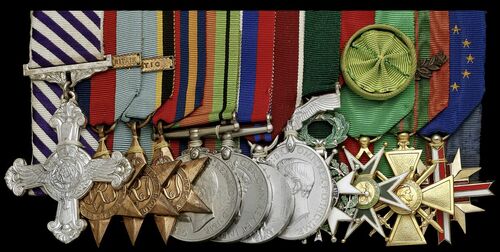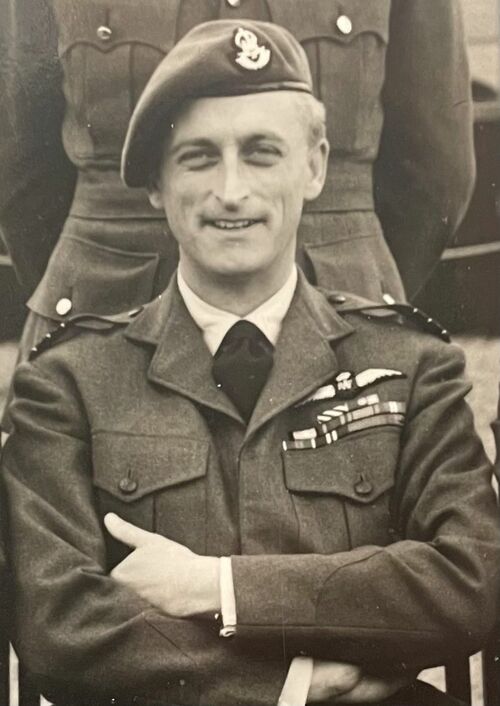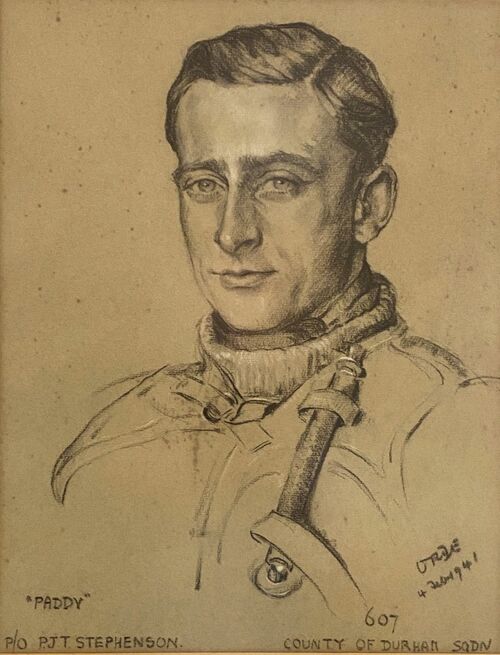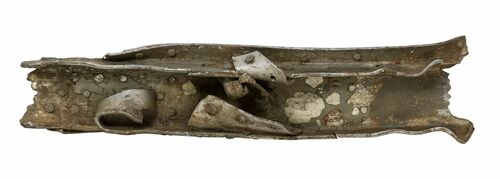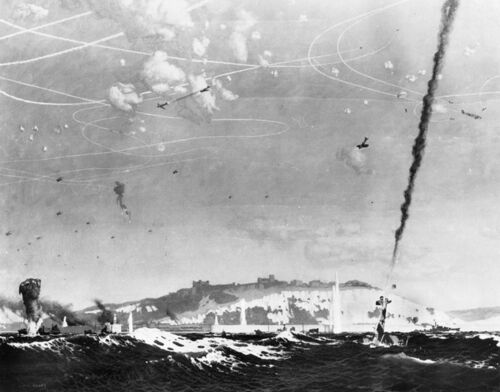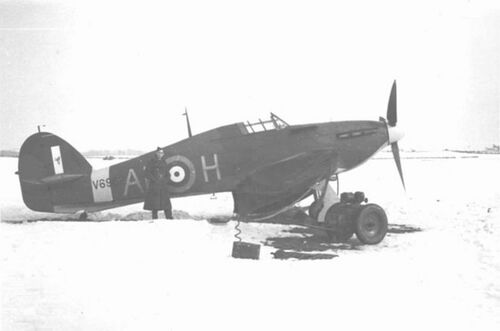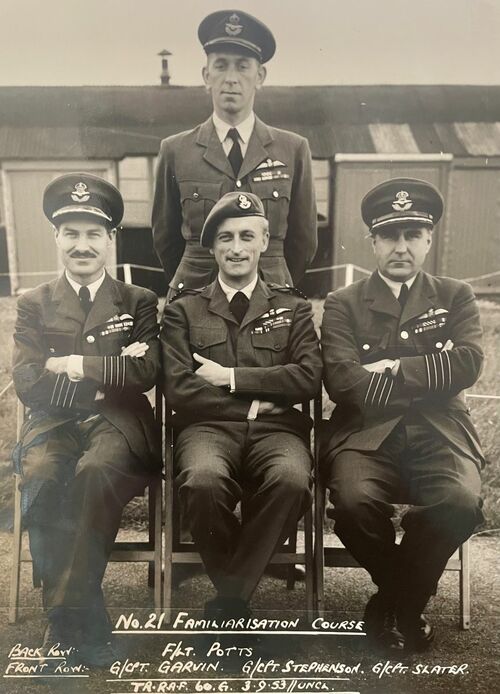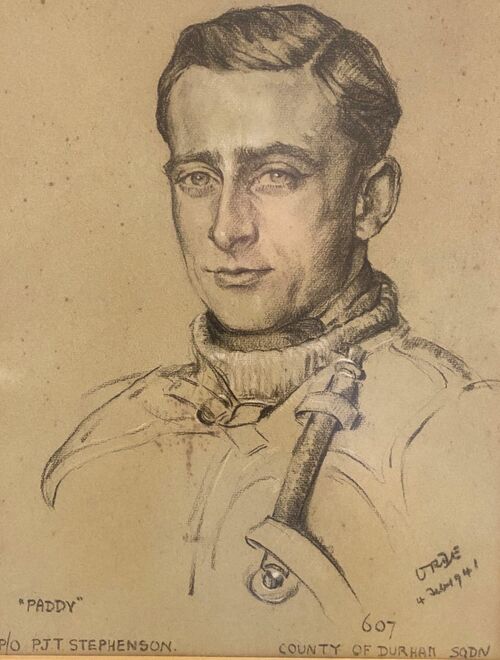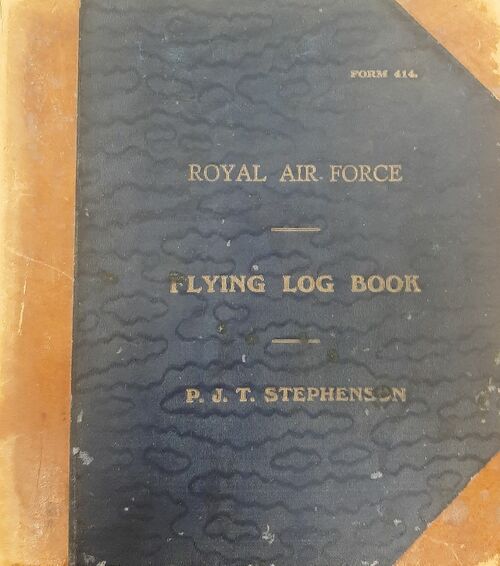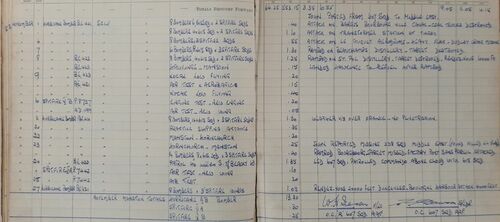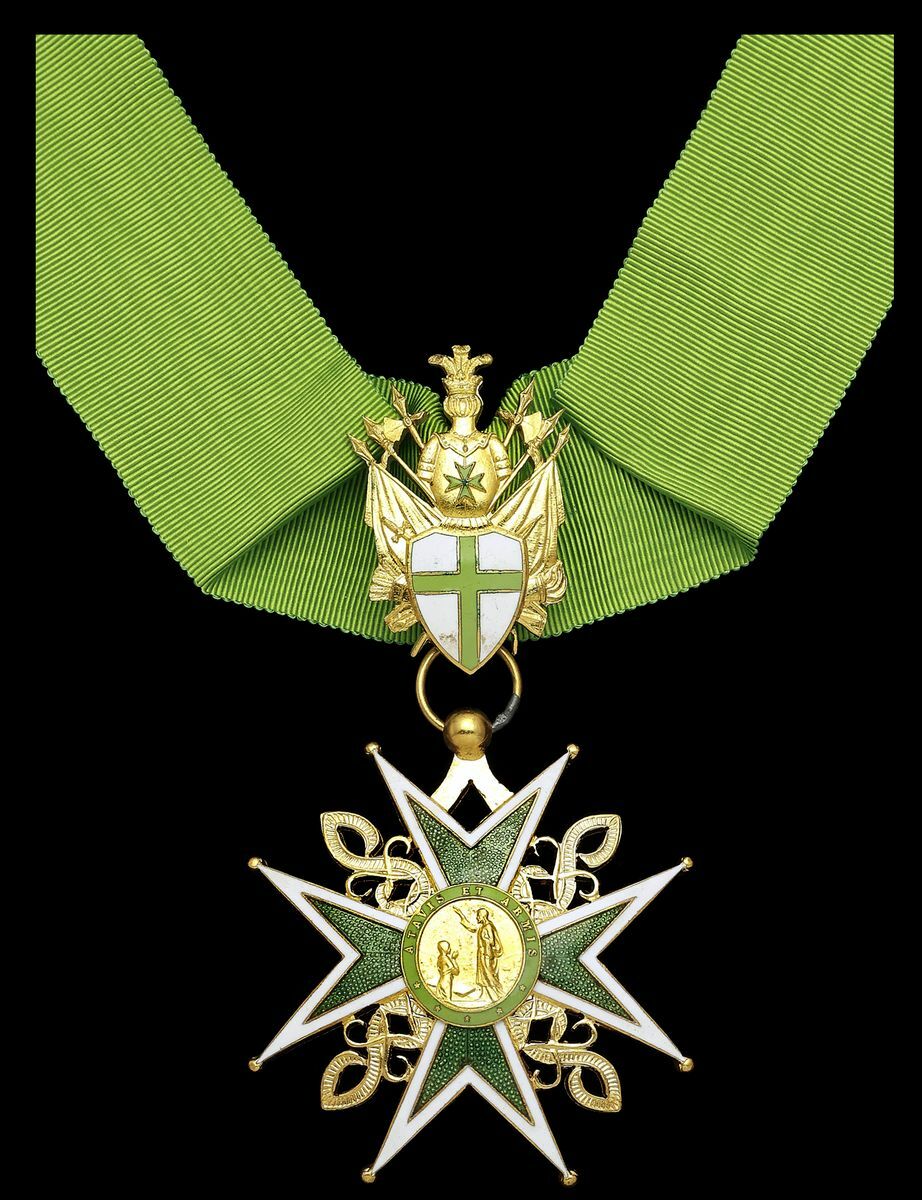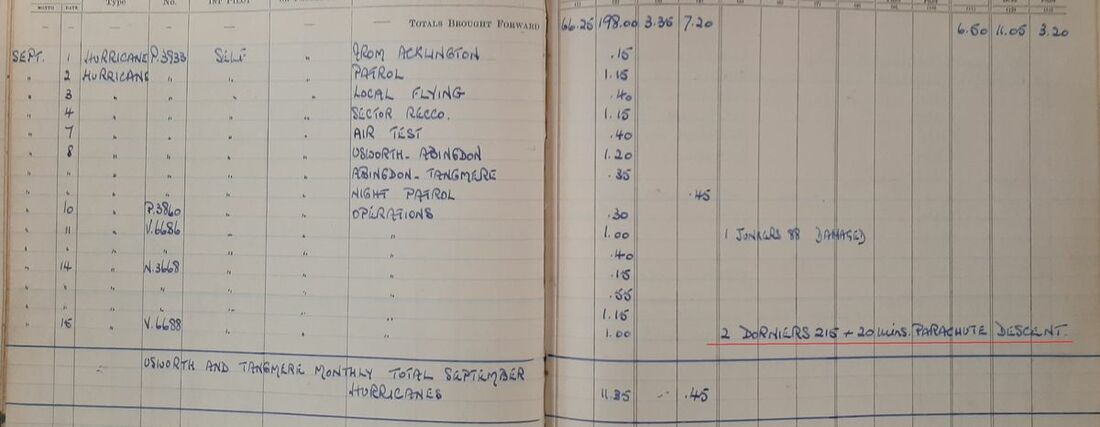Auction: 23003 - Orders, Decorations and Medals
Lot: 317
Sold by Order of a Direct Descendant
The superb 1943 D.F.C. group of fourteen awarded to Wing Commander P. J. T. 'Paddy' Stephenson, Royal Air Force
One of a handful of gallant Fighter Pilots to hail from the 'Emerald Isle', Stephenson cut his teeth in the Hurricanes of No. 207 (County of Durham) Squadron during the Battle of Britain; these 'weekend flyers' pulled no punches and he fearlessly ran head-on into a swarm of Do215's on the most critical day of all - 15 September 1940 (Battle of Britain Day) - his attack didn't require the cannon and Stephenson shed both the wings on his aircraft when ramming two enemy bombers destined for London; despite being wounded on the way in and going into a wingless inverted dive, he downed both and took to his parachute to save his life
Having been painted by Cuthbert Orde, Stephenson 'wangled' his way back into a combat role by taking a demotion; it was rewarded when he downed an Me109E over La Havre in December 1941
Thence transferred to the Far East, Stephenson rose to the command of No. 607 Squadron during further scores of Ops in Burma - adding a further probable to his tally when downing an Oscar II in January 1944; he was again wounded and shot down in a huge action when a combined force of fighters engaged at least 40 enemy aircraft
Distinguished Flying Cross, G.VI.R., the reverse officially dated '1943'; 1939-45 Star, clasp, Battle of Britain; Air Crew Europe Star, clasp, Atlantic; Burma Star; Defence and War Medals 1939-45; Coronation 1953; Air Efficiency, G.VI.R. (Act. Sqd. Ldr. P. J. T. Stephenson. R.A.F.V.R.); France, Republic, Legion of Honour, silver and enamel; International, Military Order of Saint Lazarus of Jerusalem, breast Badge, with rosette upon riband; France, Republic, Legion of Honour, gilt with bronze Palme upon riband, reverse dated '1939'; France, Republic, Cross of Former Combatants of Europe; Malta, Order of Merit of the Sovereign Military Order of Saint John of Jerusalem, neck Badge, by A. Casazza, Rome, in case of issue; International, Military Order of Saint Lazarus of Jerusalem, neck Badge, the first twelve mounted court-style as worn by Spink & Son, traces of lacquer, good very fine (14)
D.F.C. London Gazette 10 September 1943.
Patrick Joseph Thomas Stephenson - or 'Paddy' to his friends and comrades - was born in Dublin on 25 August 1918 and was educated privately at schools in France, Belgium and Switzerland, gaining an early handle on languages, which would be of great use in his latter postings.
Young Stephenson was supposed to go up to Oxford University in 1934 but his father considered that sixteen was too young for him and felt that he would gain greater benefit from business experience. Thus in December 1934 he worked at Lloyd's of London, eventually becoming a cover underwriter for French Automobile Insurance.
Skyward
Stephenson joined the Royal Air Force Volunteer Reserve in September 1938 as an Airman (Under Training) Pilot and first took to the skies on 10 December 1938, with a 15 minute flight in a DH82A K.4285. He took his first solo on 3 May 1939 in the very same aircraft his first flight had taken place. By the outbreak of the Second World War he had some 55hrs 15mins on his Flying Log Books.
He was called up and completed his flying training at No. 3 F.T.S. South Cerney on No. 32 Course, which ran from 31 January-15 June 1940.
Battle of Britain - 607 Squadron
Stephenson joined No. 607 (County of Durham) Squadron at Usworth on 18 June 1940, direct from Training School. The unit were fresh from the Battle of France and Wing Commander Parrott gives a flavour of their style:
'The Auxiliaries, of course, were the pre-war weekend fliers. Of the twenty or so pilots in No. 607 Squadron just four, including myself, were regular members of the RAF. The others, and a large number of NCOs and men, were Auxiliaries from the Newcastle and Sunderland area as the home base of the squadron in peacetime had been Usworth, now Sunderland airport. Many of them had been in the shipping industry in peacetime and the honorary air commodore of the squadron was Sir Walter Leslie Runciman [later 2nd Viscount Runciman, and also the first Director General of the British Overseas Aircraft Corporation].
At 19 1/2 years old I was the youngest pilot in the squadron and found myself being treated very much like the younger brother, with a mixture of protective care and sharp discipline....The pilots were absolutely marvellous, supportive and welcoming. They knew I was living off my pay. Besides Peter Dixon there were two other regular officers: John Hutchison....who was a very nice chap and Chatty Bowen, who was on a short service commission. My first flight commander Jo Kayll. He achieved fame later in the war when he was shot down over St. Omer in France and threatened the soldiers who had come to arrest him with a revolver! He was captured and made a Prisoner of War.
Francis Blackadder, my second flight commander on ‘A’ Flight, was also a delightful and generous man. He had played rugby for Scotland in the Home Nations Championship, beating England at Twickenham in March 1937. One day four or five of us flew down to Rouen and went to that famous restaurant Coq d’Or with a sky-high bill at the end of a 3-hour lunch. I was worried that I would not have enough to pay. When the bill arrived I asked what my share was and I was shushed because it was all taken care of. This was the kind of generosity you got from them.’
Sadly, being one of just two Squadrons in the B.E.F. being equipped with Gladiators, the 'weekend flyers' found themselves in the thick of it and in dire need of fresh Pilots and aircraft. So it was that Stephenson came on board to join 'B' Flight and the unit was given use of Hurricanes.
As the Battle of Britain opened in earnest on 10 July, Stephenson was gaining experience in the air and went on his first patrol on 29 July, with further sorties of that nature in the following days and weeks, noting 'Operations' on 22 & 28 August - both flown in Hurricane P3933. As September dawned, his opportunity to engage the enemy at large would loom large. The Battle of Britain itself was coming to pitch point and it wasn't long before Stephenson would look the enemy in the white of their eyes.
So it was that on 8 September he flew down to Tangmere, that airfield having freshly 'blitzed' itself. Having barely got their feet on the ground the scramble bell tolled and at 1950hrs they were tasked to patrol the Shoreham area at 17,000ft. The 45 minute 'Night Patrol' was under the command of Flight Lieutenant Blackadder, with Stephenson in Red Section, without an encounter with the enemy. After a rest on 9 September, he flew on Operations the following day he flew in P3860. On 11 September he took part in a brace of Operational sorties, both in V6686. The first lasted an hour and saw him open his account, claiming a Ju88 damaged. He flew another 40 minute sortie in that aircraft later that day. Three Operational sorties in N3668 on 14 September followed over Poole Harbour and the Isle of Wight. The second sortie was recorded in the ORB:
'‘Combat took place 20 miles south of Selsey Bill about 1325hrs, 16,000 ft Red Section saw one Ju88 ahead proceeding South at 9,000ft. Section went into line astern carrying out individual diving attacks from astern, firing one 3 second and 2 half second bursts. E/A escaped into cloud. Plots eventually ceased and 11 Group Operations instructed Squadron to claim this E/A as destroyed. Own losses NIL’.
15 September 1940 (Battle of Britain Day) - double trouble
Stephenson would write his name into the history of the Battle of Britain on perhaps its most pivotal day of action. Aviation Classics gives a good account of the overview:
'Sunday 15 September 1940 was the day on which massed waves of Luftwaffe aircraft came to attack England expecting little opposition, though were met by a strong force of RAF fighters which hit the enemy formations with might.
As dawn broke on 15 September 1940, there was a touch of mist in the air over Southern England. But it burnt off quickly and the sun was soon shining bright through cloudless blue skies. A week ago the Germans had changed their tactics and on this day the weather was perfect for another bombing raid on London.
Lufwaffe aircrew had been told that the RAF was down to its last 50 Spitfires, so their morale was high. There had been a lull in the fighting over the past few days, and this combined with the lessening of attacks on Fighter Command airfields over the past week had given the RAF vital time to regroup. Pilots had rested, and front line units were even able to carry out valuable training of new replacements – a rare luxury for most of that frantic summer.
Similar to many other days, the action was slow to develop – controllers in the 11 Group Operations Room at RAF Uxbridge awaited the first plots with anxious anticipation. Then at around 11:00am the first signals began to arrive. A raid of 40-plus was first to be plotted, as lights on the ‘tote board’ illuminated to show that RAF squadrons had been called to standby. In quick succession more signals arrived reporting 30-plus, 40-plus, 50-plus and then an 80-plus wave of enemy aircraft. The skies across the Channel were filling up rapidly as the Luftwaffe headed towards the shores of England. The lights on the ‘tote board’ now showed that all the 11 Group squadrons had been scrambled to intercept this mighty force, with 10 and 12 Group fighters on their way to reinforce the defences.
Air Vice Marshal Keith Park gave his orders in the Uxbridge bunker, directing the fighter force into position for the best possible effect. He paced up and down observing every move to a plot on the map board making instant decisions to be passed on to his fighters as the threat changed.
Prime Minister Winston Churchill was in the Operations Room that day, and had become aware of the 11 Group Commander’s anxiety. “What other reserves have we?” asked Churchill. “There are none, sir,” Park replied.
Squadrons from Biggin Hill were first to hit the enemy, and as they tackled the swarms of bombers and fighter escorts more Fighter Command units arrived at their intended points of interception and a mass series of swirling dogfights raged around the skies in a crucial fight for survival. When the lead bomber formation neared London, it was without its fighter escorts which had got tangled up with the RAF. Thinking they may now have a clear run in, the bombers were met by the Duxford ‘Big Wing’ of five squadrons from 12 Group, which were then joined by six more from 11 Group.
Some of the bombers jettisoned their payloads at random, while those that continued on were hunted by the determined fighter pilots in their Hurricanes and Spitfires. Everything had worked, the RAF fighters were in the right place and in great numbers. The Luftwaffe was heading back for the Channel in disarray, but they were to try again.
Early that afternoon more waves headed for England, led by a fighter sweep. That too met with fierce resistance, and as the bombers began to arrive over land again they were again hit hard. Two more raids were attempted, but by 16:00 South East England was littered with the smouldering wrecks of Lufwaffe aircraft, while more went home trailing black smoke.
The RAF fighter squadrons had been able to use the defensive system to great advantage that day, and being out in such numbers it had the necessary effect. After this great victory the Germans had learnt that their chance of a passage into England was over; on this day the RAF had effectively shown it had won the Battle of Britain. While the war was not won for some time to come, and the success had come at great cost to the civilian population who had been bombed instead of the fighter stations, this day perhaps more than any of the conflict to date marked a turning point in the eventual Allied victory. Thus this date is still marked each year as Battle of Britain Day.'
Flying in Hurricane V6688, the Flying Log Book of Stephenson gives his own account of his part in the day:
'2 Dorniers 215 + 20 mins. Parachute Descent.'
His own Combat Report gives further details:
'I was flying Green2 with the section which went into a head on attack on a formation of Do215’s
with escorting fighters above and behind the formation. Owing to the position of my aircraft and that of another Hurricane the usual break-away was not possible before other avoidable action could be taken I crashed into a Do215 with my right wing. The wings of both planes were seen to
break up.
The Hurricane was then again hit by another Do215, this time in the left wing. As a result my plane went into a (wingless) inverted dive from which I escaped by parachute, landing near Tenterden. The Squadron CO saw the two Do 215’s crashing in the neighbourhood of Tenterden.'
The official record actually confirms that he had taken out Do17z-3 (3458) of Kampfgeschwader 3, when he purposely collided with her at 1515hrs. The enemy aircraft crashed and exploded in an orchard in Combwell Wood, Kilndown, Goudhurst, taking the lives of Oberleutnant Becker-Ross, Oberfeldwebel Bruckner and Feldwebel Hansen, with Feldwebel Brinkmann missing. After the aircraft came to ground, many locals went to search for 'souvenirs', unaware that several of the bombs had not been released. When it exploded, it cost the lives of three locals and wounded a further nine. The unidentified remains of the downed airmen were buried at All Saints Churchyard, Staplehurst. The crash site was excavated in 1972 and many items are displayed at the Robertsbridge Aviation Museum.
Horst Shulz, who flew on the German side, gave a view of things:
'The next moment there was an explosion in front of me, then pieces of the planes were falling out of the sky like confetti. I didn't know whether a British fighter had collided with one of our planes, or if it had suffered a direct hit from flak. There was no time to brood about it, I had my own job to do.'
No. 607 Squadron had attacked a formation of Do17s in the area of Appledore and they carried out a head-on attack; it was during this first run that Stephenson made contact. He had in fact been slightly wounded by return fire on the way in and showed no fear in the action on this pivotal way. In the Combat Report Stephenson confirms he lost his right wing when hitting - and downing - the first enemy bomber and taking it's wing off too. Flying with just one wing he then hit the second Do215, taking off his remaining wing - downing the second enemy aircraft in the process - thence himself ending up in an inverted wingless dive. Kicking to get out of his stricken aircraft, he damaged his ankle in the process but managed to get free. V6688 crashed at Swifts Park, Cranbrook.
His contribution in this climatic day of action meant that as the sun set on 15 September 1940, the enemy had lost around 60 aircraft at the cost of just 26 Royal Air Force fighters. They had held firm and the Battle of Britain was secured. Two days later, Hitler would postpone preparations for Operation Sealion, the invasion of Britain. Due to the mounting losses of airmen, aircraft and the lack of adequate replacements, the Luftwaffe abandoned daylight raids and continued with nighttime bombing.
A 'brush' of note
Recovered from his ordeal, he was back in the air on 10 October and shared in the 'Beginning of the Training of New Pilots' the following day. Remaining with No. 607 Squadron, on 15 October his Flying Log Book notes 'Led Section through 11,000ft of cloud'; quite an experience that would have been. Removed to No. 96 Squadron in December, he rejoined No. 607 Squadron at Christmas. As 1941 begun, Stephenson again made a note of interest on 4 February:
'John and I had our portraits painted officially by Capt. Orde. R.F.C..'
The original of that striking artwork remains with the family but it is reproduced for the first time in public for your enjoyment. Training duties beckoned
and on 12 March 1941 he joined No. 53 O.T.U., together with his old friend John Edward Sulman (who also scored a 'kill' on 15 September 1940) '...by the helping hand of W/C J. I. T. Jones DSO MC DFC MM.' The pair were in the air together in June 1941 when he was permitted to use 'coloured cine film...camera gun attacks on John' whilst flying Spitfire X4781. The next day he also turned out flying in formation for Press Reporters.
Promoted Flight Lieutenant on 18 August 1941, he shared in several practice dogfights, clearly wanting to get himself back into the thick of things.
Wangle
On 26 September 1941, Stephenson noted 'Reduced to Flying Officer - Wangle to rejoin 607 Sqd.' He flew in a Squadron patrol off Dungeness the very next day. In the period that followed, he got more than the fair share of action that he wished for, the unit now operating with Hurricane Bombers:
'1 November - BE426 - Attack on Barnes Bourgourg Ville Canal - Coal Trucks Destroyed.
1 November - BE426 - Attack on Transformer Station at Tingey.
4 November - BE426 - Attack on Le Touquey Aerodrome - Heavy Flak - Dudley Craig missing.
7 November - BE426 - Ramrod on Beauchamps Distillery - Target destroyed.
8 November - BE423 - Ramrod on St Pol Distillery - Target destroyed.
23 November - BE426 - John reported missing 238 Sqd Middle East (found killed El Gubi). Ramrod Bourgbourg. Target missed. Factory Pont Sans Pareil attacked.
24 November - BE422 - Led 607 Sqd. Patrolled Commando above cloud with 615 Sqd.
27 November - BE421 - RV 20000ft Dungeness-Boulogne Harbour attack 4000ft.
5 December - BE426 - Roadstead Le Havre. No shipping damage. Attacked by 109E's. 1 Confirmed.'
His Combat Report takes us inside the cockpit:
'According to my instructions, I continued down the French Coast with Red and Yellow Sections (A Flight 4 A/C) leaving ‘B’ Flight (S/L Mowat) who attacked the first group of shipping. ‘A’ Flight attacked a trawler steaming westwards out of Le Havre, about a 1/4 of a mile from the mole. I then ordered “Reform, home” over the R/T and proceeded towards a beehive of Hurricanes orbiting approx 7 miles out to sea from Cap de la Havre. Red2 Sgt Cravoisier (French) was with me at this
point, and the two A/C of Yellow Section were just leaving the harbour area, the defences of which were now firing.
While I was still about 3 miles from the beehive four Me 109’s broke cloud cover above and to starboard of me; I shouted “Fighters- Fighters” to warn the beehive and proceeded to carry out attacks on the E/A. They approached in a dive at speed and passed in front and above me, before turning sharply to starboard down to sea level.
They held their fire until within about 70yds of the Hurricanes, one of which I saw go straight into the sea, I was now carrying out a stern 1/4 attack on one of the e/a but could not see any results. The e/a did a
complete left hand climbing turn which I followed. At about 500 ft when I was again facing the beehive the leading e/a started a shallow dive attack, giving me a shot from full beam position. I aimed considerably forward on his line of flight and the e/a flew straight through my sights. Strikes were seen all along the fuselage, but no material damage was apparent. The e/a had been firing during the dive; this ceased after my burst and the e/a continued it’s shallow dive into the sea.
2 Me 109’s then endeavoured to get on my tail, with the result that all three aircraft were manoeuvring for position in a tight left hand turn. Just as I was getting into position for shooting, the e/a broke off combat, climbing rapidly away. They then positioned themselves 800 ft above and to starboard of me, and carried out a forward 1/4 attack. This I evaded, enemy fire passing to the starboard and behind me. I was by this time quite alone and returned to base without seeing any other a/c.'
Hurricanes in Burma - Higher Command
No. 607 flew its Hurricanes out to India in June 1942. Landing at Dum Dum on 3 August 1942 he met Air Vice-Marshal Stevenson and the following weeks saw the unit preparing to be thrown back into action in this new theatre. September 1942 saw him fly his first Ops in Burma, including a sweep near Chittergong and numerous trips in the region of Cox's Bazar and up the Kaladan River. Having been delivered long-range Hurricanes in November 1942, this enabled the Squadron to strike out. Stephenson provided Bomber Escort on 19 November, bombed Jessore Aerodrome from 12,000ft on 22 November and bombed railway junctions on 25 November. He put in a low level machine-gun and canon attack on Magwe Aerodrome on 29 November for good measure.
Little respite was offered to the Fighter Pilots in the Far East during the Second World War and the Flying Log Books of Stephenson are fine evidence of that. A few entries give a flavour of his exploits:
'21 December 1942 - Attack on Aerodrome. Heavy flak. F/Sgt Richardson missing.
24 December 1942 - Low level attack on Magwe. 607 out as fighter cover attacked by 6 'ois' F/O Fergusson missing. Result for Squadron 1 confirmed, 2 probables, 2 damaged.'
16 January 1943 - Military supply train attacked N. of Pinta.
17 January 1943 - Chindwin River Patrol. Destroyed 'F' Model lost previous day with F/O Krause. Also attacked sampans, 2 steamers, lorry + railway trucks. Intercepted by 4 'ois' over Blue Mt. and chased home.'
Promoted Acting Squadron Leader on 21 March 1943, Stephenson assumed Command of No. 607 Squadron, a fine result having joined the unit straight from his training course. Removed for No. 1 Fighter Course from 14 March-4 April 1943, the unit moved back to the front on 29 November 1943, seen off by Group Captain Fullergood and Air Commodore Rowley. After an attack on 1st Light Aerodrome on 5 December, he flew on Operation 'Rat' on 7 December, noting '80 x 30 ton tanks being landed.'
The Squadron was visited by Mountbatten on 16 December and they gave him cover to view the forward area of the operational zone at Ramu.
Further kill - D.F.C.
As 1944 begun, No. 607 were back on Ops:
'15 January - Spitfire VC MA857 - Intercepted two enemy fighter sweeps one of 9+ another of 3+ over Buthdaung area. Squadron score 8 destroyed, 3 probables and 10 damaged. All our planes unscratched. I got one Oscar Mark II Probable.'
Having further added to his score in that Op, Stephenson was shot down in an unfortunate 'blue-on-blue' during a frenetic combat in which at least 40 enemy fighters engaged No. 607 & 136 Squadrons. Stephenson was wounded in the arm but his Squadron added 2 destroyed, 3 probable and 3 damaged to their score. He was posted to 3rd Tactical Air Force and joined the personal Staff of Mountbatten at Kandy, not before he had climbed to 37,000ft in a test in Spitfire VIII JF271 on 16 March 1944.
Made Acting Wing Commander on 20 June 1944, Stephenson was appointed to RAF Fayid, with responsibility for converting Pilots for service in the Far East. He also flew to provide Fighter Escort to Field Marshal Smuts who was returning from the San Francisco Conference in July 1945, flying on the escort into Cairo and thence onto Cape Town.
Journey's end
Falling back on his good handle of languages, Stephenson was Assistant Air Attache in Paris and Deputy Head of the Air Mission from 1945-49. He was rewarded with a brace of French awards to go with his D.F.C. for his troubles. By the time he retired on 31 July 1955, his Log Book totalled some 1,455hrs. His combat record during the Second World War stands at 3 kills (2 in one combat on Battle of Britain Day) & 1 probable. Married in London in December 1949, the Wing Commander emigrated to Canada and became a Canadian citizen in September 1960. He returned to the United Kingdom and died at Hexham, Northumberland on 20 May 2003; sold together with his Flying Log Book (Form 414), this with several photographs and qualifications pasted in, besides a desk flag.
Also offered together with a small section of the Dornier wreckage, which has been kindly donated by the Robertsbridge Aviation Society, re-united with the Medals of Stephenson for the first time.
References:
Battle of Britain Day: 15 September 1940, Alfred Price.
The Pilot In The Poster Peter Parrott, R. Parrott.
Those Other Eagles, Christopher Shores.
With thanks to Simon Muggleton for accessing Combat Reports and the Operational Record Books of No. 607 Squadron.
Subject to 20% VAT on Buyer’s Premium. For more information please view Terms and Conditions for Buyers.
Sold for
£14,000
Starting price
£9500

